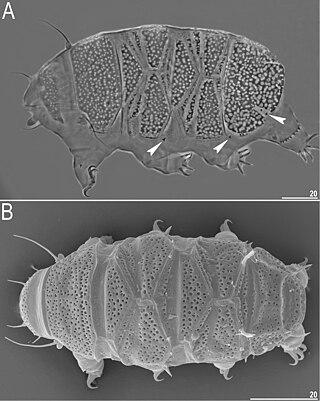
Hypsibius dujardini sensu lato is a species complex of tardigrade in the class Eutardigrada. A member of this complex, Hypsibius exemplaris, is widely used for various research projects pertaining to evolutionary biology and astrobiology.

Echiniscus testudo is a cosmopolitan species of tardigrade.
Diphascon is a genus of water bear or moss piglet, a tardigrade in the class Eutardigrada.
Pseudobiotus is a genus of water bear or moss piglet, a tardigrade in the class Eutardigrada.

Ramazzottius is a genus of water bear or moss piglet, a tardigrade in the class Eutardigrada.
Itaquascon is a genus of water bear or moss piglet, a tardigrade in the class Eutardigrada.

Isohypsibius is a genus of water bear or moss piglet, a tardigrade in the class Eutardigrada.
Eremobiotus is a genus of tardigrade in the class Eutardigrada.

Eohypsibiidae is a family of water bear or moss piglet, tardigrades in the class Eutardigrada. It contains the following species in three genera:

Milnesium is a genus of tardigrades. It is rather common, being found in a wide variety of habitats across the world. It has a fossil record extending back to the Cretaceous, the oldest species found so far is known from Turonian stage deposits on the east coast of the United States.Milnesiums are one of the most desiccation and radiation-resistant invertebrates on Earth because of their unique ability to transform into a "tun" state and utilize intrinsically disordered proteins when experiencing extreme environments.

The Echiniscidae are a family of tardigrades, a phylum of water-dwelling, eight-legged, segmented micro-animals. It is one of the four families in the order Echiniscoidea. The family was named by Gustav Thulin in 1928.

Echiniscus is a genus of tardigrades in the family Echiniscidae. The genus was named and described by Karl August Sigismund Schultze in 1840.
Pseudechiniscus is a genus of tardigrades in the family Echiniscidae. The genus was named and described by Gustav Thulin in 1911.
Bryodelphax is a genus of tardigrades in the family Echiniscidae. The genus was first described by Gustav Thulin in 1928.
Macrobiotidae is a family of tardigrade. As of 2023, it consists of the following genera:
Macrobiotus is a genus of tardigrade consisting of about 100 species.
Pseudechiniscus is a species of tardigrade in the family Echiniscidae. The species is endemic to the island of São Tomé in São Tomé and Príncipe. The species was first described by Paulo Fontoura, Giovanni Pilato and Oscar Lisi in 2010.
Bertolanius is a genus of tardigrades belonging to the family Eohypsibiidae.
Mesobiotus is a genus of tardigrades belonging to the family Macrobiotidae.








